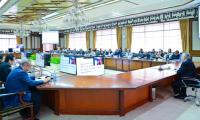The birth of International Women’s Day in the early 20th century was strongly linked to labour movements and socialism. The women’s rights movement emerged with the rise of working-class movements and was linked with revolutionary movements of the working class for radical social transformation and reconstruction of society.
This day is a reminder that all the democratic, economic, legal and political rights that women enjoy today were won through struggle and sacrifice. It shows us what can be achieved through struggle, solidarity and unity.
International Women’s Day is the story of ordinary women as makers of history; it is rooted in the centuries-old struggle of women to participate in society on an equal footing with men. It is a global celebration of the social, economic, cultural and political achievements of women.
The day is a time to reflect on the progress made, to call for change and to celebrate acts of courage and determination by ordinary women who have played an extraordinary role in the history of their countries, societies and communities.
Historically, the day was about highlighting the relationship between capitalism and women’s oppression, and that remains significant today. Capitalist exploitation, repression, sexism, discrimination and gender inequality still exist. In many countries around the world, women still face all sorts of restrictions, social segregation and reactionary customs and medieval traditions.
Women played a key role in national freedom struggles, revolutionary movements of the working class, anti-war movements and democratic struggles against dictatorships and authoritarianism in the 20th century. They fought for peace, equality and revolutionary change.
Young girls and women are facing state repression and brutalities at the hands of occupied forces in Kashmir and Palestine for participating in legitimate independence movements. Millions have been killed, displaced, sexually abused and continue to suffer in Syria, Yemen, Libya, Afghanistan and other countries due to wars and internal conflicts.
International Women’s Day inherited a tradition of protest and political activism. The economic and social conditions forced them to enter into struggles and movements to change their conditions. In the years before 1910, from the turn of the 20th century, women in industrially developing countries were entering paid work. Their jobs were mainly in textiles, manufacturing and domestic services where conditions were wretched and wages even worse. They had no other option but to fight back.
It all started with a strike organised by young female garment workers in New York in 1908. Their victory inspired the Socialist Party to organise ‘Women’s Day’ marches across the country in March 1910. The New York march demanded higher wages and better working conditions, along with women’s suffrage.
This strike, fought by thousands of young women who worked long hours for meagre wages in New York City’s garment factories, is one of the most important struggles in the history of the US working class.
In 1910, an International Socialist Women’s Conference, organised in Copenhagen and including women from 17 countries, voted to establish an annual International Woman’s Day to promote equal rights and women’s suffrage on the proposal of German Socialist Clara Zetkin.
The Russian Revolution of 1917 was also triggered by women workers. It was on International Women’s Day in 1917 that Russian women workers organised massive strikes and demonstrations against war, high prices, and the situation of women workers. The main slogan of this strike movement was Bread and Peace. The strike movement spread very quickly, overturning the czarist dictatorship and triggering the Russian Revolution that achieved final victory in October of that same year.
Women’s day is the celebration of the tradition of struggle, sacrifice and courage. This is a tradition to convert pain, suffering and helplessness into strength and power.
The writer is a freelance journalist.
The post-election situation will be troublesome and worrisome for Modi
Most favourable concept developed so far revolves around public-private partnerships
There is only one way forward: cut non-development expenditures, including non-combat defence expenditure
The plan aims to ensure financial stability, control inflation, and promote economic prosperity
Currently, a staggering 60 per cent of government revenue is being wasted on interest payments
It seems that Beijing’s goodwill, stronger financial stature, principle of non-interference in domestic affairs and...







